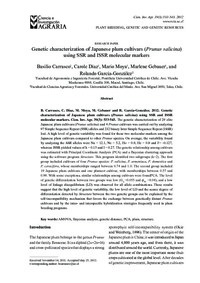Mostrar el registro sencillo de la publicación
Genetic characterization of Japanese plum cultivars (Prunus salicina) using SSR and ISSR molecular markers
| dc.contributor.author | Carrasco, Basilio | |
| dc.contributor.author | Díaz, Carole | |
| dc.contributor.author | Moya, Mario | |
| dc.contributor.author | Gebauer, Marlene | |
| dc.contributor.author | García-González, Rolando | |
| dc.date.accessioned | 2017-11-16T14:08:30Z | |
| dc.date.available | 2017-11-16T14:08:30Z | |
| dc.date.issued | 2012 | |
| dc.identifier.uri | http://repositorio.ucm.cl/handle/ucm/1258 | |
| dc.description.abstract | The genetic characterization of 29 elite Japanese plum cultivars (Prunus salicina) and 4 Prunus cultivars was carried out by analyzing 97 Simple Sequence Repeat (SSR) alleles and 232 binary Inter Simple Sequence Repeat (ISSR) loci. A high level of genetic variability was found for these two molecular markers among the Japanese plum cultivars compared to other Prunus species. On average, the variability found by analyzing the SSR alleles were Na = 12.1, Ne = 5.2, Ho = 0.9, He = 0.8 and F= -0.127, whereas ISSR yielded values of h = 0.15 and I = 0.27. The genetic relationship among cultivars was estimated with Principal Coordinate Analysis (PCA) and a Bayesian clustering approach using the software program Structure. This program identified two subgroups (k=2). The first group included cultivars of four Prunus species: P. salicina, P. armeniaca, P. domestica and P. ceracifera, whose memberships ranged between 0.74 and 1.0. The second group included 19 Japanese plum cultivars and one plumcot cultivar, with memberships between 0.57 and 0.99. With some exceptions, similar relationships among cultivars were foundPCA. The level of genetic differentiation between two groups was low (Gst =0.055 and ST =0.04), and a low level of linkage disequilibrium (LD) was observed for all allele combinations. These results suggest that the high level of genetic variability, the low level of LD and the scarce degree of differentiation detected by Structure between the two genetic groups can be explained by the self-incompatibility mechanism that favors the exchange between genetically distant Prunus cultivars and by the intra- and interspecific hybridization strategies frequently used in plum breeding programs. | es_CL |
| dc.language.iso | en | es_CL |
| dc.rights | Atribución-NoComercial-SinDerivadas 3.0 Chile | * |
| dc.rights.uri | http://creativecommons.org/licenses/by-nc-nd/3.0/cl/ | * |
| dc.source | Ciencia e Investigación Agraria, 39(3), 533-543 | es_CL |
| dc.subject | AMOVA | es_CL |
| dc.subject | Bayesian analysis | es_CL |
| dc.subject | Genetic distance | es_CL |
| dc.subject | PCA | es_CL |
| dc.subject | Plum | es_CL |
| dc.subject | Structure | es_CL |
| dc.title | Genetic characterization of Japanese plum cultivars (Prunus salicina) using SSR and ISSR molecular markers | es_CL |
| dc.type | Article | es_CL |
| dc.ucm.facultad | Facultad de Ciencias Agrarias y Forestales | es_CL |
| dc.ucm.indexacion | Scopus | es_CL |
| dc.ucm.indexacion | Isi | es_CL |
| dc.ucm.indexacion | Scielo | es_CL |
| dc.ucm.doi | dx.doi.org/10.4067/S0718-16202012000300012 | es_CL |



